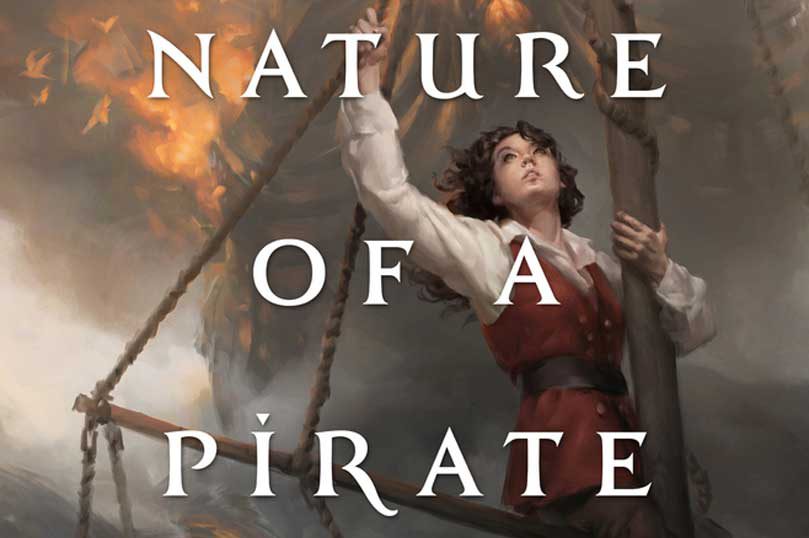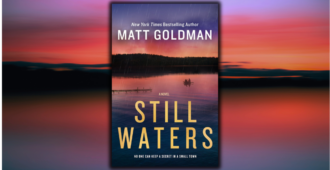 Marine videographer and biologist Sophie Hansa has spent the past few months putting her knowledge of science to use on the strange world of Stormwrack, solving seemingly impossible cases where no solution had been found before.
Marine videographer and biologist Sophie Hansa has spent the past few months putting her knowledge of science to use on the strange world of Stormwrack, solving seemingly impossible cases where no solution had been found before.
When a series of ships within the Fleet of Nations, the main governing body that rules a loose alliance of island nation states, are sunk by magical sabotage, Sophie is called on to find out why. While surveying the damage of the most recent wreck, she discovers a strange-looking creature—a fright, a wooden oddity born from a banished spell—causing chaos within the ship. The question is who would put this creature aboard and why?
The quest for answers finds Sophie magically bound to an abolitionist from Sylvanner, her father’s homeland. Now Sophie and the crew of the Nightjar must discover what makes this man so unique while outrunning magical assassins and villainous pirates, and stopping the people responsible for the attacks on the Fleet before they strike again.
The Nature of a Pirate, the third book in Alyx Dellmonica’s Stormwrack series, will become available December 6th. Please enjoy this excerpt.
CHAPTER 1
Kitesharp was bleeding.
The wounded ship was fifty feet long, with a crew of fourteen sailor-mechanics, and when dawn rose over the Fleet of Nations, her blood trail was just a thin line of crimson threaded into her wake. It twisted against the blue of the sea, a hint of pinkish foam that might have gone unnoticed for hours if it hadn’t begun attracting seabirds and sharks.
The whole Fleet watched as the birds shrieked and Kitesharp’s captain raised a warning cone up her mainmast. Soon—presumably after her bosun had been below for a look—a sphere was raised, too. From a distance, both cone and sphere would appear as flat shapes, seeming to onlookers to be a triangle and circle. It meant Ship in distress. Help required.
This particular distress call had gone out twice before.
By midmorning the blood trail was a foot wide and the ship had taken on enough water to raise her bow well above the surface.
The greatest of the Fleet rescue vessels, Shepherd, was ready. Her crew brought her alongside the craft as traffic flowed past. Working with military precision, Shepherd’s crew lowered a walking bridge to Kitesharp’s deck and boarded personnel: twenty workers, first, to help the crew load the doomed ship’s tools and fixtures, to strip whatever they could. Yards of hang glider silk were waiting to be off-loaded, along with the flexible boards that made up the skeletons of the gliders’ wings. There were bright streamers that carved the kites’ paths through the sky, above the sails of the Fleet, and pots upon pots of dyes, glues, and needles. Everything that wasn’t bolted down, including the sailors’ personal trunks, was already packed.
Shepherd also brought soldiers, fit young adults bearing stonewood swords and a grim sense of purpose. They would search the boat from main deck to bilge, looking for intruders. They brought a spellscribe, who was tasked with seeking anything that might tell them about the intention—a curse, some whispered—that had been worked upon the vessel.
For this third sinking, they also brought Sophie Hansa.
Raised in San Francisco and trained as a biologist, Sophie had been working as a marine videographer until she fell into—… well, she was essentially applying twenty-first-century science to puzzles the locals couldn’t work out, here on Stormwrack. She had come in search of her birth parents, following them to a society that lived largely at sea, on a world whose existence had been concealed from Earth.
Since then, she’d done everything from hunting for a newfound aunt’s murderers to determining international ownership rights over a species of migrating turtles.
The locals were strangely hampered by a cultural taboo against curiosity. Sophie had realized that her best chance of being allowed to stay was by channeling her natural desire to ask questions in ways that earned her political goodwill.
Lately she had been mining the judiciary’s warm case files, seeking out little mysteries that might be cleared up with a bit of fact finding or a basic application of science.
But now someone was sinking small civilian ships that followed Stormwrack’s Fleet, the great oceangoing capital city that circled the world, keeping the peace and policing piracy. Knowing the sinkings were caused by magicians wasn’t helping the authorities. So, here was Sophie, in her wetsuit, with her tanks and camera and a solar-charged LED lamp, about to take an exploratory plunge through a sinking ship.
“What will you need from us?” asked the head of the Shepherd rescue crew, a twentysomething woman, Southeast Asian in appearance (although that meant little here, on this world of tiny island nations) named Xianlu. She was all business. “Kir Zophie?”
Right. Concentrate. “Ship’s already taking water—do you know where it’s coming from?”
“The aft hold.”
“I’ll start there, before it gets any deeper.”
The officer summoned one of her crew,—a broad-shouldered guy with the build of a high school quarterback, clad in a tight-fitting uniform designed for swimming. He looked familiar; after a moment, Sophie realized she had seen him at a disastrous Fleet graduation ceremony she’d attended after she had first arrived here, in the spring, eight months ago.
“Escort Kir Zophie below.”
He bobbed his head in assent and gestured for Sophie to follow.
“Get the sails down, move and double,” Xianlu ordered, turning her attention to the crews waiting at the ropes.
Kitesharp had a high, snub profile in the water that reminded Sophie of a modern towboat, despite her sails and rigs. Her bow was tilting up as she continued to take water in the stern.
“What’s your name?” Sophie asked the boy as they worked their way past a work crew busily sealing the tins of hang glider dye.
“Tenner Vale, Kir.”
“‘Tenner’ was a ranking for cadets. It meant he had a full ten years left on his term of service. “Graduation was a while ago, wasn’t it?”
He nodded. “In four months, after my exams, I’ll be a niner. Xianlu is a septer.”
“Do you stay a tenner if you fail the tests?”
He did a double take, probably thinking, How can you not know that? Then, having apparently decided she wasn’t joking, he said, “A decade is a decade. Niners who’ve failed their exams are given posts with less responsibility.”
“Drop and stow, one, two!” The crew lowered the mainsail. The canvas and rigging loosened and fell to the deck with a sound like a hundred drumbeats. The ship had already been given up for lost. Kitesharp, but for the ropes that bound her to Shepherd, was now at the mercy of the waves.
“Like a wounded animal,” Sophie murmured.
Vale looked frustrated, almost ashamed. “We would fight to save her, if we understood how she’s being sunk.”
They had to be desperate to turn to me, Sophie thought. Stormwrackers were ambivalent about science. Much of it they labeled atomism and dismissed as unreliable, even dangerous. People preferred to believe in a patchwork of disciplines with as much merit as astrology or dousing.
Wrackers could navigate ships by the stars. They built and used barometers. But they also thought that observing the flame from a yellow candle would tell them the emotional state of a prevailing wind, and that aspirin worked by “encouraging the spirit to bend like a willow around its hurts.”
Sophie was getting away with working for the courts by rebranding her skills. What she was bringing to the table wasn’t atomism at all—that was the story. It was a shiny new discipline dubbed “forensic.”
Same old wheel, shiny new rim.
Vale opened a hatch, revealing a ladder. Giving him what she hoped was a reassuring smile, Sophie stepped into the hold. The tilt of the ship was more obvious here; she crab-stepped her way down the inclined deck and opened another hatch, peering into a flooded chamber.
“Thanks.” She put on her flippers and descended alone. The hold was half full of waist-high salt water. She took a careful stance on the deck, set her light, and began filming, taking a shot of the whole room first, just in case. She captured everything visible above the waterline.
“It is water,” she noted.
That look again: of course it’s water. “Your pardon, Kir?”
“The ship’s gushing blood, but filling with salt water. There’s no blood here, so where’s it coming from?”
He gave the half shrug, a bob of shoulders that was the unofficial Wracker ward against curiosity.
Having filmed it, she took time to look with the naked eye. “You know if anyone has schematics for the ship? Plans?”
“I believe so, Kir.”
“To work out how fast the water’s coming in, we’ll need an accurate measurement of cabin volume.”
“A sailing master can do the calculations, if it’s important.”
She didn’t bother to say that, with the right measurements, she could do it herself. “While I’m down there, I want you to record how long it takes the water level to rise from here…” She put her hand on one of the ladder rungs.—“To this one. Do you understand?”
He made a gesture, indicating rising water. “Sink rate per ten count?”
“Exactly. Do you have something that counts seconds for you?”
Vale nodded. “And a measuring rope, Kir.”
“Good. As accurate as you can, please.” She set her watch to record the diving time.
“Understood, Kir.”
Something in his tone made her think of Captain Parrish; she felt a pang of something that was equal parts longing, loneliness, and frustration.
Forget Garland. It’s time to focus on the not-so-smart dive of the day. Still with a hand on the ladder, she checked her camera’s waterproof housing, put on her mask and rebreather, took a few breaths, and then bent her knees to bring her face below the level of the rising water. Shining the light around the narrow space, she looked for floating debris or loose rope—anything that might knock or entangle her. But the crew had worked upward from the compromised stern when they began emptying out their ship; the space was empty. Sophie half swam, half crawled to the low point, camera and light at the ready.
She hoped to find a gaping hole in the hull, of course, something to account for whatever was hemorrhaging into the seas behind the ship. But at first glance, there was nothing. No hole, no bubbles, certainly no blood.
Nothing to patch. If she could be patched, she could be saved.
The answering thought came in her brother’s voice: If it had been easy, they wouldn’t have asked you to help, Ducks.
Taking out a bulb filled with blue-black squid ink, she squeezed out a drop, then another, working her way along the floor. The first two drops swirled lazily. The third moved and dispersed, propelled by a current coming up from the boards.
She put out a hand, discovered the pressure of inrushing water, and worked her way toward it, seeking its source by touch.
Here, on the hull. She pushed in close. On the wood there was a waxy mark, dark red on the oak boards, barely visible.
It was the outline of a hand.
She held her position, working the light and camera together to get a decent shot of the outline. It was biggish, with a stubby, truncated pinkie.
The red looks waxy, like crayon, she thought.
Releasing her camera—it was tethered—she dug into her tool kit again, selecting a steel scalpel she’d imported from home. Working carefully, she tried to scratch some of the waxy stuff into a test tube. It didn’t want to come.
She tried again, pushing harder. If she could pry up a splinter of the wood …
Softness, like flesh.
The blade broke a chip of the wax-marked wood loose, but the force of Sophie’s hand drove it inside the outline of the hand. Instead of glancing off of more wood, it dug into something with the give of meat.
All at once, the outline came to life, fingers flexing blindly to grab at the scalpel. As it did, the hull gaped and cracked. A surge of cold water pushed inward. The back of the hand, the part that had been outside the ship, was covered in shreds of bloody tissue.
Like Cousin It from the Addams family. No, It’s the one with all the hair. Like Thing, just a hand—eww, hand—but grab that splinter …
Sophie caught the chunk of wood with its wax smear, tucking it into her sample tube. Kicking, she put some space between herself and the hand. She reeled her camera back, aimed the light, and started recording video.
The incoming water had more force now.—She could feel it gushing past, the sensation reminiscent of water jets in a hot tub. As the hand curled in, leaving a deep, five-fingered hole in the hull, Sophie’s diving light picked up barnacles, streamers of seaweed, and gory, spongy-looking masses on the back of the hand, the side that had been in the water.
Sophie snagged a hunk of red tissue, too, clipping it into another specimen flask without taking her eyes off the hand.
The outline on the boards was growing now, the drawn edges of the wrist extending as if someone was there, drawing in both lines with crayon. The hand grew a wrist, then a forearm. It bent at the elbow, and the boards of the hull reshaped themselves into an arm. It lashed about as it groped at the inside of the ship.
Sophie swam farther back. The thing, as it detached itself, was ripping ever-greater holes into the bottom of Kitesharp.
What happens when it grows a head?
It’d be dumb to wait around and find out, wouldn’t it? She kicked back to the ladder. The tenner, Vale, was timing seconds and measuring water rise.
“Anything, Kir?”
She spat out her rebreather. “Found a monster! Up, up!”
A shudder ran through the ship, accompanied by a sound of splintering wood so loud it drowned out Vale’s reply. He offered Sophie his hand.
The incline of the deck grew more steep by the minute as they charged to the nearest ladder out of the hold.
“You first, Kir.” The kid drew a shortsword.
Sophie fought an impulse to argue. What was she going to do, fight a monster in her diving rig?
Another splinter. The deck below them cracked, splitting up the middle. The ship listed sharply to starboard.
“Teeth!” Vale cursed. “Ship’s splitting down the middle!”
They scrambled out onto the deck.
The blood slick around Kitesharp had become a dense red puddle, a crimson smear broken by tissue and bits of debris. Shark fins stirred in the murk. A boarding plank, extended from Shepherd, was stretched across the gap between the two ships. A half-dozen of Xianlu’s crew stood ready, waiting for Sophie and her escort.
The ship began to buck, as if something big had taken hold and was shaking it.
“There!” Sophie pointed, as the wooden hands rose to the main deck, one after another, the leading edge of a wooden body covered in gore and sea-slime, pushing up through the hatch as if it were forcing itself through a birth canal.
“Wood fright!” someone shouted.
“This far asea? How did it seed?”
The deck heaved. The hatch broke in zigzag fissures. As the hands came down onto the deck they seemed to stick—roots grew from the wooden palms into the planks, and the fright had to rip them out, causing more damage.
It did not breathe. A person would have been panting with effort, but this, whatever it was, had the eerie stillness of a store mannequin.
Sophie trained her camera on it as it raised its head.
Are its eyes covered in moss?
The thing began to stride across the crumbling deck of Kitesharp, ripping holes in the boards as its feet fell and rooted, rose and tore loose. It made straight for Shepherd.
Sophie could feel the bridge underfoot moving as they pulled away. Vale and Xianlu were guiding her so she could keep filming and still move backwards in her flippers. Unless the thing could jump a hell of a long way—Why couldn’t it?—there was no chance it’d catch them.
“Someone called this a wood sprite?” Xianlu asked.
“Wood fright, Septer,” someone else corrected. “Used on Mossma, before the ban, to guard forests. And for murders, sometimes.”
“Frightmaking’s illegal,” Vale said.
“I said before the ban.”
“Was anything like this aboard the other ships?” Sophie asked.
“If so, it sank with them,” Xianlu said.
“I think I woke this guy before he was fully baked,” Sophie said.
It was a guy; the body was unmistakably male, and on the slender side. He had a limp.
A limp and … a foreshortened pinky? She zoomed in on its hands.
The thing began to run toward them.
“Gunner battery one! Fire!”
Stormwrack didn’t have cannons.—They used magically transformed specialists instead. Three sailors stepped up and hurled flaming spheres at the wood fright.
It pulled up short, throwing both arms up to defend its head—giving Sophie a good shot of all ten fingers—and then disappeared in a burst of fire, leaving an appalling stench of scorched meat and campfire behind.
As the smoke from the cannons dispersed, the remains of the sailing mechanics’ shop, Kitesharp, fell to pieces and vanished beneath the waves.
Copyright © 2016 by A. M. Dellamonica
Buy title here:













Comments are closed.
Leave a Reply